全球动脉粥样硬化血栓形成门诊患者中心血管危险因素的患病率、认知和治疗
International prevalence, recognition, and treatment of cardiovascular risk factors in outpatients with atherothrombosis作者机构:Cleveland Clinic Foundation 9500 Euclid Ave Cleveland OH 44195 United StatesDr.
出 版 物:《世界核心医学期刊文摘(心脏病学分册)》 (Digest of the World Core Medical Journals(Cardiology))
年 卷 期:2006年第2卷第5期
页 面:13-14页
学科分类:1002[医学-临床医学] 100201[医学-内科学(含:心血管病、血液病、呼吸系病、消化系病、内分泌与代谢病、肾病、风湿病、传染病)] 10[医学]
主 题:心血管危险因素 动脉粥样硬化 血栓形成 门诊患者 治疗强度 患病率 全球 认知 外周血管疾病 高胆固醇血症
摘 要:Context: Atherothrombosis is the leading cause of cardiovascular morbidity and mortality around the globe. To date, no single international database has characterized the atherosclerosis risk factor profile or treatment intensity of individuals with atherothrombosis. Objective: To determine whether atherosclerosis risk factor prevalence and treatment would demonstrate comparable patterns in many countries around the world. Design, Setting, and Participants: The Reduction of Atherothrombosis for Continued Health(REACH) Registry collected data on atherosclerosis risk factors and treatment. A total of 67 888 patients aged 45 years or older from 5473 physician practices in 44 countries had either established arterial disease(coronary artery disease[CAD], n=40 258; cerebrovascular disease, n=18843; peripheral arterial disease, n=8273) or 3 or more risk factors for atherothrombosis(n=12 389) between 2003 and 2004. Main Outcome Measures: Baseline prevalence of atherosclerosis risk factors, medication use, and degree of risk factor control. Results: Atherothrombotic patients throughout the world had similar risk factor profiles: a high proportion with hypertension(81.8% ), hypercholesterolemia(72.4% ), and diabetes(44.3% ). The prevalence of overweight(39.8% ), obesity(26.6% ), and morbid obesity(3.6% ) were similar in most geographic locales, but was highest in North America(overweight: 37.1% , obese: 36.5% , and morbidly obese: 5.8% ; P .001 vs other regions). Patients were generally undertreated with statins(69.4% overall; range: 56.4% for cerebrovascular disease to 76.2% for CAD), antiplatelet agents(78.6% overall; range: 53.9% for ≥ 3 risk factors to 85.6% for CAD), and other evidence-based risk reduction therapies. Current tobacco use in patients with established vascular disease was substantial(14.4% ). Undertreated hypertension(50.0% with elevated blood pressure at baseline), undiagnosed hyperglycemia(4.9% ), and impaired fasting glucose(36.5% in those not known to



